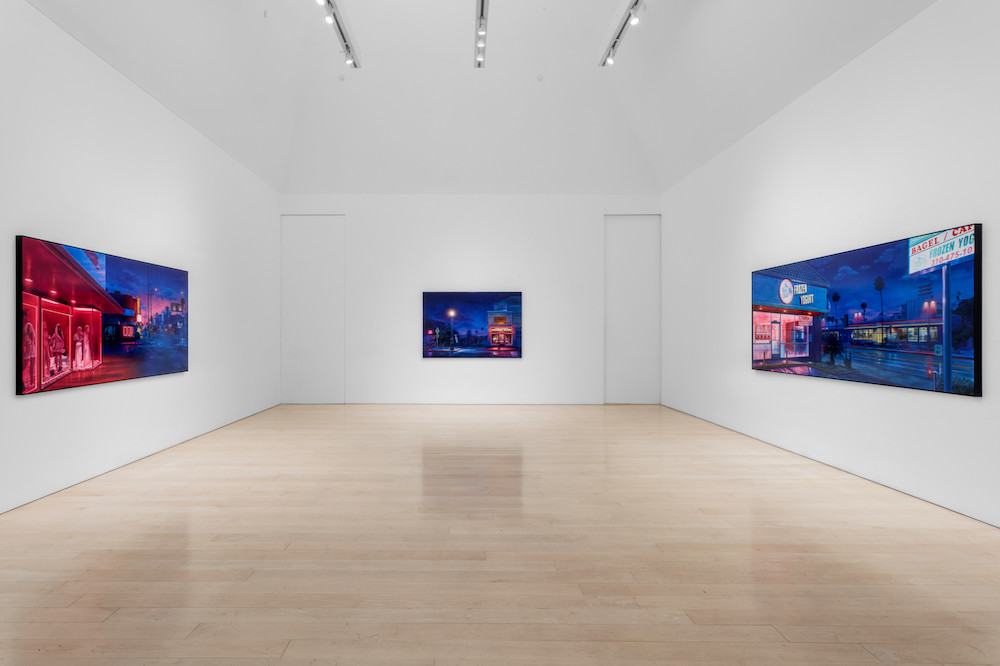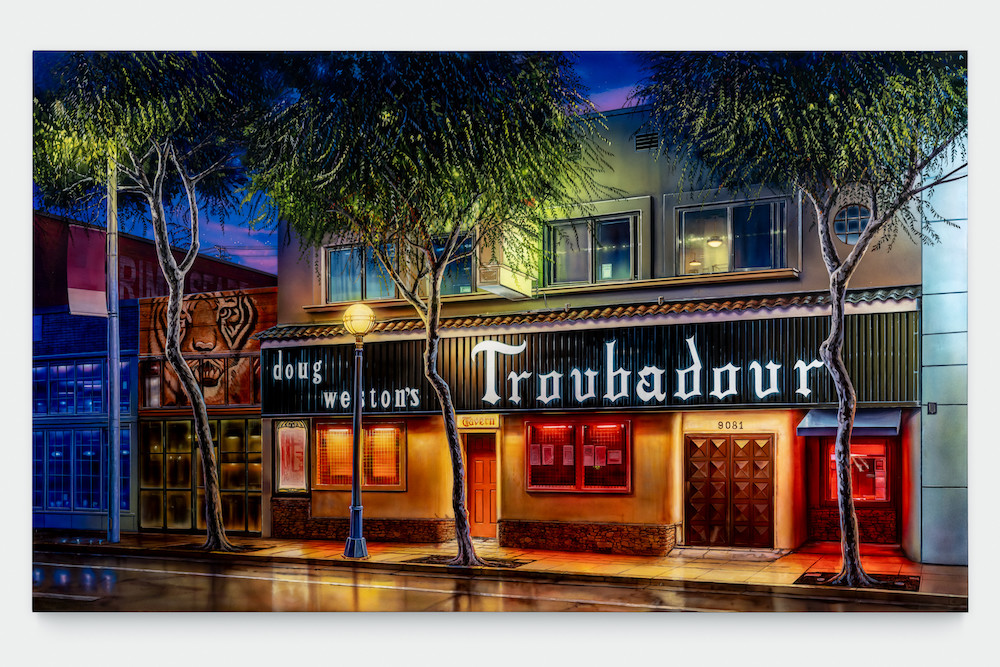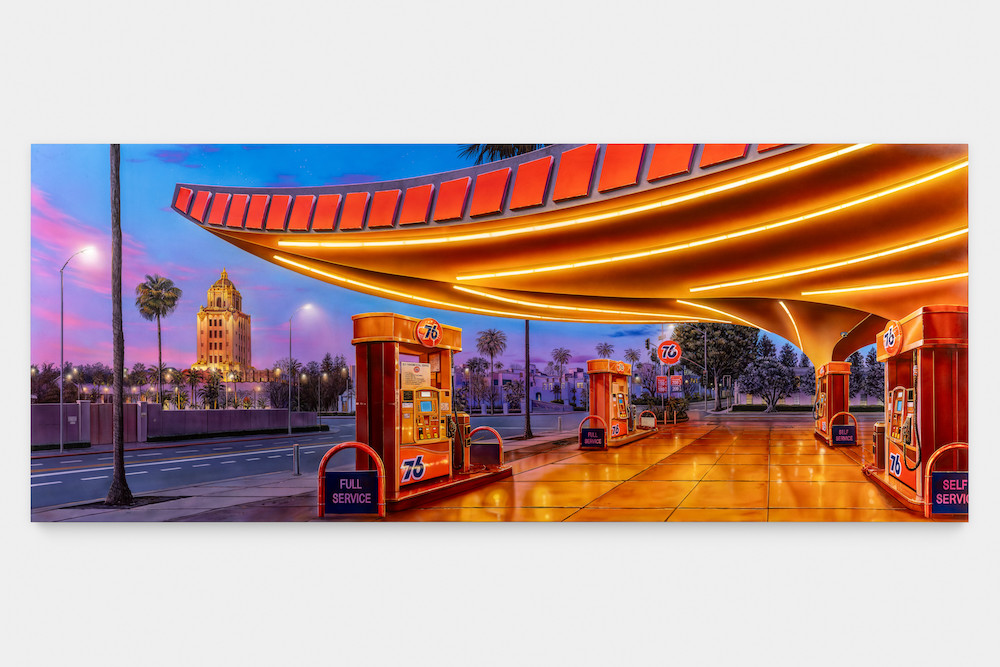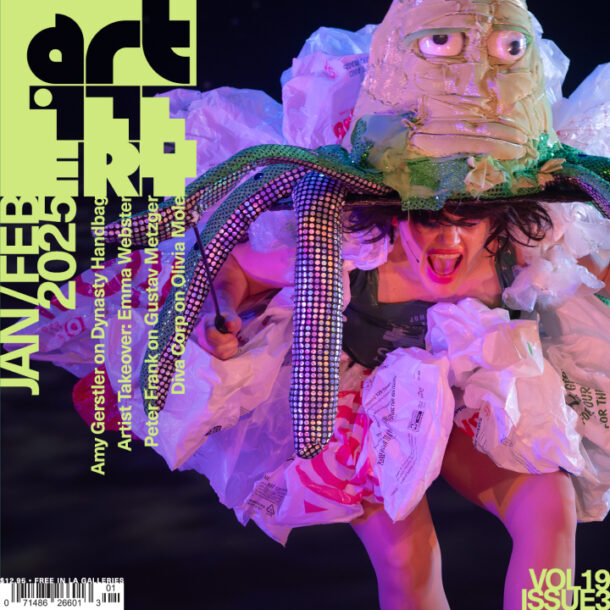To prepare for his current show “Noir” at Gagosian, Alex Israel claims to have walked about fifteen thousand steps per day around Los Angeles. This is highly unusual and, honestly, suspect. As the saying goes, no one walks in LA. Yet Israel insists on it and says that all this walking clued him into the more subtle, textured aspects of the city —things “[he] wouldn’t ever clock from the car window”—which ultimately informed his paintings.
In an attempt to better understand Israel and his work, I, too, began taking seven-mile walks around the city, daily: Van Nuys to Canoga Park, Glendale to Alhambra. El Prado to Sunset Tower. And so on and so on. I did my best to see the city as I imagined Israel would. I got into character—Alex Israel, wunderkind artist—and adopted that carefree, near-smug affect I’d seen in all of his portraits online. I did things that I thought he would do: I wore Ray Bans, smiled at nothing in particular, and listened to songs from mid-2000s iPod commercials. Slowly but surely, I started to feel cool and unhurried, the star of my own private sequel to Nic Refn’s neo-noir Drive: Walk.
Such a confident approach gave me clarity, and I realized that Israel was right. After seven miles of walking per day, you do start to notice the city’s hidden textures. Most obviously: for all their disuse (or perhaps because of it), the sidewalks are remarkably perilous, so full of fissures and crags that even a brief daydream comes at the cost of an ankle.

Alex Israel, “Noir,” installation view, 2025. Photo: Charles White. Courtesy of Gagosian.
LA’s terrain, it turns out, is not easy. So, I’m surprised when I finally arrive at Israel’s “Noir” in Beverly Hills (by way of the Sherman Oaks Galleria, a four-hour walk through Benedict Canyon) to find a suite of paintings illustrating the exact opposite.
Apparently, Israel’s LA is easy. His paintings depict LA landmarks, both well and lesser-known—Chateau Marmont and the Troubadour, but also Trashy Lingerie and Hollywood Liquor—so completely awash in golden-hour purples and pinks that they’d fit neatly into one of Damien Chazelle’s La La Land dance numbers. Streets are glassy. Lights splash. Cars and people don’t exist. Notably: everything works. That is to say, as in Chazelle’s film, the city in these paintings is frozen in pure fantasy, in an artificial memory of what LA never was.
But that doesn’t mean they aren’t true.
Sure, everything here is totally contrived. Yes, the paintings were made on the Warner Bros. lot (where Israel keeps his studio), an iconic factory of cultural engineering. Yes, they were painted not by Israel himself, but by his ostensible assistant, the last remaining artist in Warner Bros.’ Scenic Art department, a place once known for painting the backdrops that manufactured cinematic reality. And yes, they’re untethered from time. Showroom, for example, depicts the Googie-style Casa de Cadillac dealership in Sherman Oaks with an Escalade dating to 2021; Gas Station shows the Beverly Hills 76 – a Mid-Century Modern wonder – with the price of a gallon at $1.59, situating it sometime around 2001 (though possibly earlier, since that specific station runs hot), yet with a pump model from 2020; and Chateau Marmont presents us with an Angelyne billboard that first appeared in the 80s, alongside an Apple ad from the mid-aughts.

Alex Israel, Troubadour, 2024. © Alex Israel. Photo: Josh White. Courtesy of Gagosian.
But Israel isn’t trying to hide the artifice. He emphasizes it every step of the way – in lore, process, content and color. Some of his paintings’ dimensions are even directly proportional to cinema’s 16:9 widescreen ratio, and others to the billboards that dot the Sunset Strip, once again pointing to that which is constructed, sold, and nominally fake.
It’s precisely because these paintings are so wholly contrived that they become true. Israel leans into the city’s cliché—its fakeness, its artificiality—to highlight its depth. Vapid, you say? How about we empty it out entirely, then smooth it over and paint it like a static backdrop on a soundstage? The move is clever and conceptually sound, and it allows us to at once realize the incredible familiarity we have with our city, while also recognizing its impossibility. To live in LA is to constantly wake up from a dream you’d rather remain in. It’s not so much nostalgia as it is the stuff of romance, and of tragedy.
The paintings don’t go much further than this, and I’m not sure they have to. I could, however, stretch the show a bit further and note the fact that, at their most fundamental, these paintings are glorified depictions of LA real estate, which happens to be the source of Israel’s family fortune (his father is the developer Eddie Israel). So, while there is a base note of reverence throughout, maybe there’s also a tinge of guilt by association, of complicity. After all, these landmarks and their iconic features, not to mention the subcultures associated with them, will inevitably get lost in the very wave of real estate development that allowed Israel the opportunity to paint them in the first place. In other words, without this city, these paintings wouldn’t exist, but without these paintings, perhaps the city would.
Alex Israel: Noir
Gagosian
456 N. Camden Drive.,
Beverly Hills, CA 90210
February 6 – March 22, 2025


